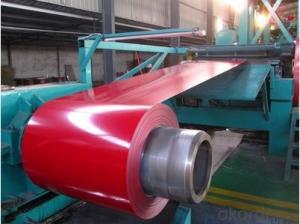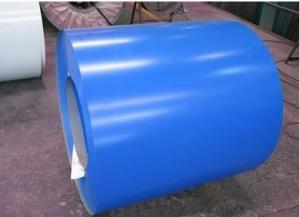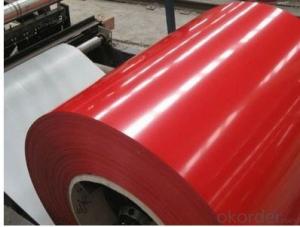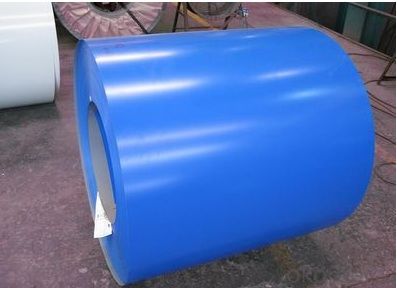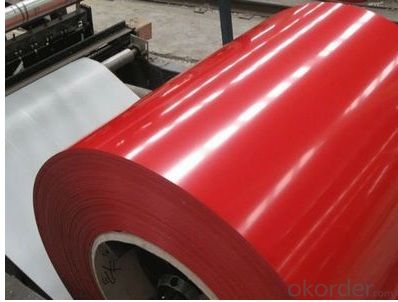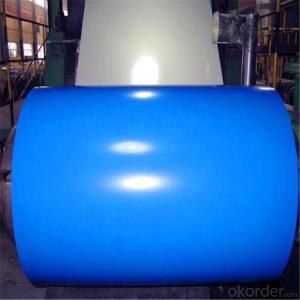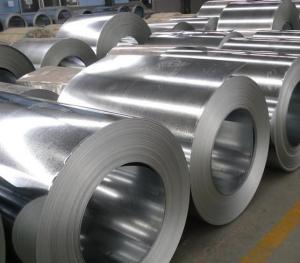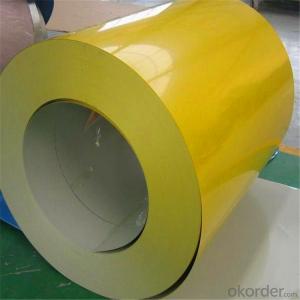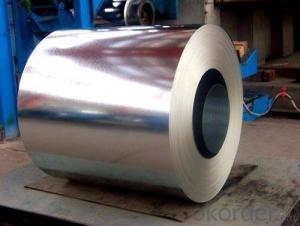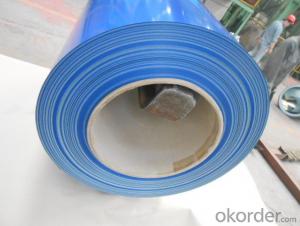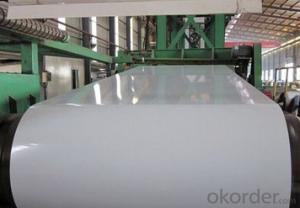PRIMER GOOD COLOR PPGI GALVANIZED STEEL COIL
- Loading Port:
- Tianjin
- Payment Terms:
- TT OR LC
- Min Order Qty:
- 25 m.t.
- Supply Capability:
- 20000 m.t./month
OKorder Service Pledge
OKorder Financial Service
You Might Also Like
Specification
Product Brief Introduction
PRIMER GOOD COLOR PPGI JIS ,with Gi as base metal after pretreatment ( degrease and chemical treatment) and liquid dope with several layers of color then after firing and cooling finally the plate steel is called Pre-painted galvanized steel is good capable of decoration ,molding corrosion resistance
Product Features
Excellent process capability
Smooth and flat surface
Workability durability
Excellent heat resistance performance
High Strength
Good formability
Good visual effect
Product Specification
Standard:ASTM, GB,JIS,JIS G3302 ASTM 755 EN10169
Grade: DX51D CGCC CS
Thickness: 0.13mm~3.0mm,
Width: 1250,600-1250mm
Coil weight:3-12 MT
Coil ID:508/610mm
Chemical composition:
C | Si | Mn | Cr | Ni | P | S |
0.150 | 0.476 | 11.231 | 12.50 | 0.900 | 0.039 | 0.010
|
FAQ
1. How long will we receive the goods ?
45days after receiving workable L/C
2. how do you control the quality ?
we have our own quality control department ,we will arrange QC person to see the production line ,when goods finish ,before shipment ,our QC person will check the quality as per our test report request ,if the goods is ok ,then we issue the test report ,and we allow the goods shipping ,otherwise will not allow ship the goods.
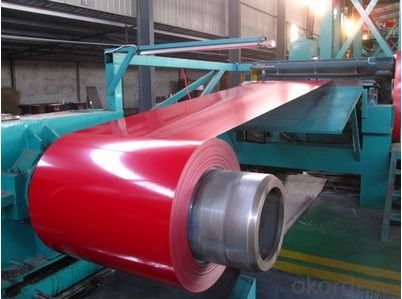
- Q: What are the challenges in coil recoiling for high-strength steel?
- There are several challenges associated with coil recoiling for high-strength steel. Firstly, high-strength steel is known for its increased hardness and strength, which makes it more difficult to coil compared to regular steel. The higher tensile strength of high-strength steel puts more stress on the recoiling equipment, leading to potential damage or failure of the machinery. Secondly, high-strength steel tends to have lower ductility, meaning it is less able to withstand deformation without fracturing. Recoiling high-strength steel coils requires careful handling and control to prevent any excessive bending or stretching that could cause the material to break or crack. Another challenge is the shape memory effect of high-strength steel. This phenomenon causes the material to return to its original shape after being deformed. While this property can be advantageous in some applications, it complicates the recoiling process as the steel coil may resist being reshaped into a new coil form. Furthermore, high-strength steel often has a more complex microstructure compared to regular steel, with different phases and grain boundaries. This complexity can make the recoiling process more challenging as it may affect the material's mechanical properties and response to deformation. Lastly, the surface finish of high-strength steel coils is critical for many applications. Recoiling can introduce surface defects, such as scratches or marks, which may affect the functionality or appearance of the final product. Therefore, maintaining a high-quality surface finish during the recoiling process is a significant challenge. In summary, the challenges in coil recoiling for high-strength steel include the increased stress on recoiling equipment, lower ductility, shape memory effect, complex microstructure, and the need for a high-quality surface finish. Overcoming these challenges requires specialized equipment, precise control, and careful handling to ensure the integrity and quality of the recoiled high-strength steel coils.
- Q: 420 440 1045 or 1065 ive bought knifes with these steel grades and i want to know which one is better.
- SAE 440 is the best. Classified as high grade cutlery steel. There are various grades of 440: A, B, C, and F. 440 A is the most stain resistant while 440 C has the most carbon and can achieve the highest hardness (Best edge Retention). SAE 440 Chemistry: 16 - 18% Chromium, 0.60 - 1.2% Carbon, 0.75% Molybdenum. SAE 420 is pretty good. Classified as cutlery steel, it is a stain resistant grade but has less chromium and significantly less carbon than SAE 440. SAE 420 Chemistry: 12 - 14% Chromium, 0.15% Carbon (min), 0 Molybdenum Chromium is what makes the steel corrosion resistant. It also adds toughness. Molybdenum adds extra corrosion resistance and adds hardenability. So you can see by chemical components that 440 is highest quality although that also means more cost. 1045 and 1065 are low quality steels and you should probably never use them for a knife. The 1 indicates plain carbon steel with little other alloying elements. The last two digits indicate how much carbon is in the steel. 1045 has 0.45% carbon, mid-range hardenability. 1065 has 0.65% carbon, high hardenability. So if I had to choose I would choose 1065 over 1045 but the difference isn't that noticeable. Everything I said here assumes they have all had the optimum Quench and Temper heat-treatment for their chemistry grade.
- Q: Hello. No freakin' website has no dam info on what products have carbon steel in them. I know it's in cooking equipment and tools, but what tools?i.e It's in a wrench or strainerSo what products have carbon steel in them?
- 440. 440a. 440c is stainless 420hc is made just for buck knives. aus8 is a stainless steel made In japan. 1095 and 1075 are both high carbon steels 1075 is a little tougher then 1095 but the latter holds a edge better and has been used by Ka-Bar for the army and marine fighting knives since WW2 so 1095 has to be a good steel for the government to use it that long. iv got a 7 inch army 1095 on order know. but there sheaths are made in mexico the knife its self is made in new york
- Q: hello, I am trying to figure out what wok to get and came across a website that offers many woks out of different materials. what is the best, or considered original (traditional)? I have a couple of cast iron pots and pans - too heavy, so I am assuming it will take some time for a cast iron wok to heat up. what about carbon steel and stainless steel? Thanks
- Traditionally woks do take a long to heat up but the trick is that they hold the heat for a long time, so either stainless steel for convenience or cast iron for tradition. Don't use anything non stick, chinese cooking uses a lot of oil, the non-stick will just be unhealthy when it starts to burn off. The cast iron will be good because it'll heat up and keep its heat, in chinese homes that have the wok, the wok usually gets heated up throughout a few hours, you need it to be really hot all the way through all over the pan to do chinese cooking. also traditionally woks are built into home or are big and positiioned over a fire not to be moved too much, the point is to keep stiring and stiring and stiring until your food is cooked.
- Q: like, what can steel make?
- buildings bridges automobiles elevators railroads and railroad equipment appliances and many many more. Steel is used almost everywhere. reference: Iron and steel are used widely in the construction of roads, railways, infrastructure, and buildings. Most large modern structures, such as stadiums and skyscrapers, bridges, and airports, are supported by a steel skeleton. Even those with a concrete structure will employ steel for reinforcing. In addition to widespread use in major appliances and cars (Despite growth in usage of aluminium, it is still the main material for car bodies.), steel is used in a variety of other construction-related applications, such as bolts, nails, and screws.[66] Other common applications include shipbuilding, pipeline transport, mining, offshore construction, pipeline transport, aerospace, white goods (e.g. washing machines), heavy equipment (e.g. bulldozers), office furniture, steel wool, tools, and armour in the form of personal vests or vehicle armour (better known as rolled homogeneous armour in this role). .
- Q: Can steel coils be used in electrical applications?
- Yes, steel coils can be used in electrical applications. Steel coils are often used as magnetic cores in transformers and inductors, which are essential components in electrical circuits. The steel used in these coils is typically a type of high-quality electrical steel that has specific magnetic properties, such as low core losses and high permeability. These properties allow the steel coils to efficiently transfer electrical energy between different components of the circuit. Additionally, steel coils can also be used in other electrical applications, such as in the construction of electric motors and generators. Overall, steel coils are widely utilized in electrical applications due to their magnetic properties and their ability to handle high currents and temperatures.
- Q: haii, i have this guitar thats quite old and im not quite sure whether to put steel strings on it. there were very thin badly worn steel strings on it when i got it, so i think its an acoustic
- if you can get a good picture of the bridge i can tell for sure i thing steel
- Q: Can steel coils be used in marine environments?
- Yes, steel coils can be used in marine environments, but proper precautions need to be taken to prevent corrosion. Steel is prone to corrosion when exposed to moisture and saltwater, which are common in marine environments. To counteract this, the steel coils can be treated with protective coatings, such as galvanization or painting, to create a barrier between the steel and the corrosive elements. Additionally, regular maintenance and inspections should be performed to identify any signs of corrosion and take appropriate action to prevent further damage. By implementing these measures, steel coils can be effectively used in marine environments while minimizing the risk of corrosion and ensuring their durability and performance.
- Q: So...I'm learning about how steel is made and I'm wondering if there is a more environmentally friendy method. I view it as unfriendly b/c of the oxygen that is injected when the steel is in the blast furnace or electric arc furnace. This oxygen bonds w/ the carbon to produce CO and CO2. THis is necessary to reduce the amount of carbon content to produce harder steels. So what other methods are there that can be used w/o having to end up w/ co and co2? thanks
- From what I understand of it, US steel is better as the steel is more recycled than Canadian, so a lot of that oxygen / CO2 has already taken place compared to working from ore. The second reason US steel is environmentally ahead of Canadian is that US tends to use Electric Arc, while Canadian uses Basic Oxygen, Basic Oxygen uses more energy than electric arc, and I think it also uses more oxygen, but I would suspect that oxygen that it uses is 'waste oxygen' and not converted into Co2 because the Co2 process is limited by the carbon, and steel only has so much carbon.
- Q: How are steel coils used in the production of metal signage?
- Steel coils are used in the production of metal signage by being cut and shaped into the desired size and shape for the signs. The coils provide a sturdy and durable base material for the signs, ensuring their longevity and ability to withstand various weather conditions.
Send your message to us
PRIMER GOOD COLOR PPGI GALVANIZED STEEL COIL
- Loading Port:
- Tianjin
- Payment Terms:
- TT OR LC
- Min Order Qty:
- 25 m.t.
- Supply Capability:
- 20000 m.t./month
OKorder Service Pledge
OKorder Financial Service
Similar products
Hot products
Hot Searches
Related keywords
